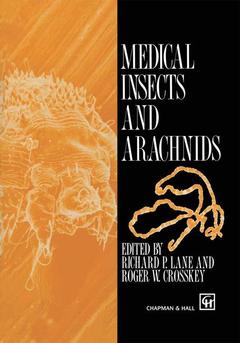Medical Insects and Arachnids, Softcover reprint of the original 1st ed. 1993
Langue : Anglais
Auteurs : Lane R.P., Crosskey R.W.

Surprising though it seems, the world faces almost as great a threat today from arthropod-borne diseases as it did in the heady days of the 1950s when global eradication of such diseases by eliminating their vectors with synthetic insecticides, particularly DDT, seemed a real possibility. Malaria, for example, still causes tremendous morbidity and mortality throughout the world, especially in Africa. Knowledge of the biology of insect and arachnid disease vectors is arguably more important now than it has ever been. Biological research directed at the development of better methods of control becomes even more important in the light of the partial failure of many control schemes that are based on insecticide- although not all is gloom, since basic biological studies have contributed enormously to the outstanding success of international control programmes such as the vast Onchocerciasis Control Programme in West Africa. It is a sine qua non for proper understanding of the epidemiology and successful vector control of any human disease transmitted by an arthropod that all concerned with the problem - medical entomologist, parasitologist, field technician - have a good basic understanding of the arthropod's biology. Knowledge will be needed not only of its direct relationship to any parasite or pathogen that it transmits but also of its structure, its life history and its behaviour - in short, its natural history. Above all, it will be necessary to be sure that it is correctly identified.
1 General introduction.- 2 Introduction to the arthropods.- One Diptera.- 3 Introduction to the Diptera.- 4 Sandflies (Phlebotominae).- 5 Mosquitoes (Culicidae).- 6 Blackflies (Simuliidae).- 7 Biting midges (Ceratopogonidae).- 8 Horse-flies, deer-flies and clegs (Tabanidae).- 9 Tsetse-flies (Glossinidae).- 10 Stable-flies and horn-flies (bloodsucking Muscidae).- 11 House-flies, blow-flies and their allies (calyptrate Diptera).- 12 Diptera causing myiasis in man.- Two Other insects.- 13 Cockroaches (Blattaria).- 14 Bedbugs and kissing-bugs (bloodsucking Hemiptera).- 15 Lice (Anoplura).- 16 Fleas (Siphonaptera).- 17 Insects of minor medical importance.- Three Arachnids.- 18 Ticks and mites (Acari).- 19 Spiders and scorpions (Araneae and Scorpiones).- Scientific names index.
They [the editors] have succeeded admirably in attaining their goal...The book is accurate and authoritative - Insecta Mundi, One of the most informative and valuable references on medical entomology ever published ... Illustrations are copious, of a very high quality and well reproduced. This is an essential medical entomology reference and will soon become a classic in the tradition of its predecessors - Biologist, This book provides a fully comprehensive introduction to the insects and other arthropods which affect human health. - Review of Medical and Vetinary Biology, A pool of biosystematic information well worth plumbing. With its abundance of illustrations (more than 700 drawings, photographs, and maps) and emphasis on easily discernable morphological features, this book should be especially welcome in university teaching laboratories. - Journal of the American Mosquito Control Association, The book is richly illustrated, particularly many line drawings and SEM micrographs show taxonomically important structures. User friendly features of the book include full labelling (instead of confusing abbreviations) of all figures and simple, clear identification keys avoiding technical terms that non specialized readers might not be familiar with. - Aquatic Insects, The text and keys are well illustrated, many of the drawings coming from previous Natural History Museum publications and all of them are of a high standard. - Annals of Tropical Medicine and Parasitology, All medically important insects and arachnids are dealt with in an organised way which shows tight editing and an unusual degree of discipline and compliance by contributors. This is the best book available on the subject. It should be used not just by entomologists, but by all workers and teachers involved with vector-borne diseases. It is well-written, authoritative and full of 'gems', the best of which concerns spiders - Parasitology Today, I had been fortunate enough to use a library copy of this e
Date de parution : 11-2012
Ouvrage de 723 p.
17.8x25.4 cm
Thèmes de Medical Insects and Arachnids :
Mots-clés :
© 2024 LAVOISIER S.A.S.



